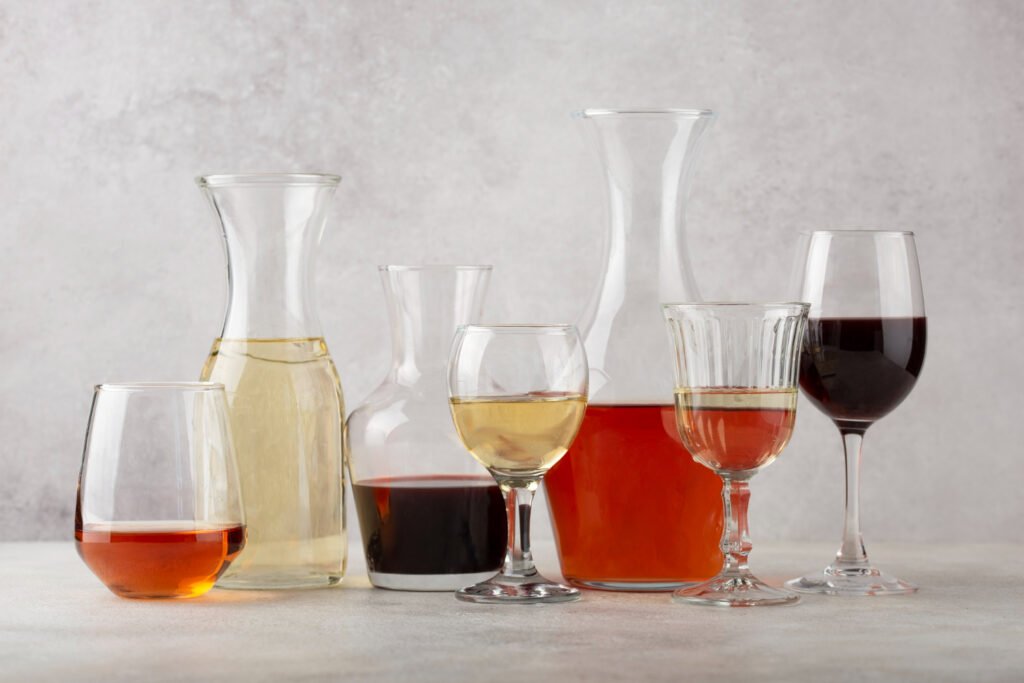
Table of Contents
Overview
Red wine has long been celebrated for its rich flavor, cultural significance, and potential health benefits. Whether enjoyed as part of a meal or as a standalone indulgence, red wine offers a complex experience that has intrigued people for centuries. However, it’s important to understand that while red wine can offer certain health advantages, it also comes with risks, particularly when consumed in excess. This guide provides a detailed exploration of the benefits, risks, and various types of red wine, helping you make informed choices about your consumption.
Health Benefits of Red Wine
Red wine is rich in antioxidants, particularly polyphenols like resveratrol, which have been linked to various health benefits. Here are some of the most notable advantages associated with moderate red wine consumption:
1. Blood Pressure Control
Red wine contains polyphenols, which may help in lowering blood pressure. Studies have shown that these antioxidants can improve blood vessel function and reduce the risk of high blood pressure, particularly in individuals with slightly elevated levels. By promoting relaxation of the blood vessels, red wine may help in maintaining healthier blood pressure readings.
2. Heart Health
One of the most well-known benefits of red wine is its positive effect on heart health. The polyphenols in red wine can help reduce the buildup of plaque in the arteries, thereby lowering the risk of heart disease. Additionally, moderate consumption of red wine has been shown to increase levels of HDL (high-density lipoprotein), commonly known as “good” cholesterol, which further protects the heart by preventing artery damage.
3. Cancer Risk Reduction
Resveratrol, a key compound found in red wine, has been studied for its potential to reduce the risk of certain cancers. Its anti-inflammatory and antioxidant properties may inhibit the growth of cancer cells, particularly in colon and prostate cancers. While these findings are promising, more research is needed to confirm the effectiveness of resveratrol in cancer prevention.
4. Reduced Risk of Alzheimer’s
Polyphenols in red wine may also have a protective effect on the brain, particularly in reducing the risk of Alzheimer’s disease. These compounds help prevent the formation of amyloid plaques, which are associated with cognitive decline and dementia. Moderate red wine consumption has been linked to a lower risk of developing Alzheimer’s and other forms of dementia, although the exact mechanisms are still being studied.
5. Lower Risk of Diabetes
Research suggests that moderate red wine consumption may reduce the risk of type 2 diabetes. A large study found that individuals who drank wine, particularly with meals, had a lower risk of developing diabetes compared to those who abstained. The protective effect is thought to be due to the combination of alcohol and polyphenols, which improve insulin sensitivity and help regulate blood sugar levels.
Potential Health Risks of Red Wine

While red wine can offer health benefits, it is not without risks, especially when consumed in large quantities. Here are some of the potential dangers associated with excessive red wine consumption:
1. Alcohol Dependence
Regular consumption of alcohol, including red wine, can lead to dependence. Alcoholism is a serious condition that can have devastating effects on both physical and mental health. If you have a history of substance abuse or are concerned about your drinking habits, it may be best to avoid alcohol altogether.
2. Liver Damage
Excessive alcohol intake is a leading cause of liver cirrhosis, a condition where healthy liver tissue is replaced with scar tissue. Drinking more than the recommended amount of red wine—2–3 glasses per day—can significantly increase the risk of liver damage. This risk is particularly high for individuals who already have liver conditions or who consume other forms of alcohol regularly.
3. Increased Cancer Risk
While moderate red wine consumption may reduce the risk of certain cancers, heavy drinking is associated with an increased risk of various types of cancer, including breast, colon, liver, and esophageal cancers. Alcohol can damage DNA in cells, leading to uncontrolled cell growth and the formation of tumors.
4. Mental Health Concerns
There is a strong link between heavy alcohol consumption and mental health disorders, particularly depression. Individuals who consume large amounts of alcohol are at a much higher risk of developing depression compared to moderate or non-drinkers. Excessive drinking can also exacerbate existing mental health conditions, leading to a vicious cycle of alcohol abuse and mental health decline.
5. Weight Gain
Red wine is calorie-dense, with most of its calories coming from alcohol. Even moderate consumption can contribute to weight gain if not balanced with a healthy diet and regular exercise. For those trying to manage their weight, it’s important to factor in the calories from red wine and adjust other aspects of their diet accordingly.
Types of Red Wine

Red wine comes in a variety of types, each offering its own unique flavor profile and best pairings. Here are some of the most popular types of red wine:
1. Cabernet Sauvignon
Cabernet Sauvignon is one of the most widely recognized and planted red wine grapes. Known for its bold flavor and high tannin content, it often features notes of blackberry, black cherry, vanilla, and green pepper. Cabernet Sauvignon pairs well with red meats, making it a popular choice for steak dinners and hearty meals.
2. Merlot
Merlot is similar to Cabernet Sauvignon but tends to be softer and more approachable, with additional notes of plum and mint. Its versatility makes it a great match for a variety of dishes, from poultry to pasta. Merlot’s smooth texture and balanced flavor profile make it a favorite among both novice and seasoned wine drinkers.
3. Malbec
Malbec is known for its rich, tannic flavor with notes of plum, black cherry, chocolate, and mocha. This wine pairs exceptionally well with beef, pork, and bison, making it a popular choice for grilled meats and barbecue. Malbec is particularly well-known in Argentina, where it has become the country’s signature red wine.
4. Zinfandel
Zinfandel, especially the Californian variety, is bold and fruity, often featuring flavors of blueberry, peach, and spice. It’s a great match for barbecue and richly flavored meats. Zinfandel’s robust flavor profile makes it a versatile wine that can be enjoyed with a wide range of dishes, from spicy foods to sweet desserts.
5. Pinot Noir
Pinot Noir is lighter in body and color compared to other red wines, with a bright, acidic flavor profile that includes notes of mushroom, strawberry, and cola. It’s a versatile wine that pairs well with poultry, seafood, and vegetable dishes. Pinot Noir’s delicate balance of flavors makes it a popular choice for pairing with complex and subtle dishes.
Nutritional Facts of Red Wine
A standard serving of red wine is about 5 ounces, which contains approximately:
- Calories: 125
- Protein: 0.1 gram
- Fat: 0 grams
- Carbohydrates: 4 grams
- Sugar: 1 gram
In addition to these macronutrients, red wine provides small amounts of essential vitamins and minerals, such as iron, calcium, potassium, and phosphorus. However, the majority of the calories in red wine come from alcohol, with the rest from carbohydrates, primarily derived from the grape skin and residual sugars.
Should You Drink Red Wine?

If you enjoy red wine, there’s no need to give it up, provided you consume it in moderation. In Europe and America, moderate consumption is typically defined as 1–1.5 glasses per day for women and 1–2 glasses per day for men. It’s also recommended to have 1–2 alcohol-free days per week to allow your body time to recover.
However, it’s important to consider your individual health circumstances. If you have a history of substance abuse, a family history of alcoholism, or certain medical conditions like gout or liver disease, it may be best to avoid alcohol altogether. Pregnant women and those with specific health concerns should also refrain from drinking red wine.
The Takeaway
Red wine, when enjoyed responsibly, can be a delightful addition to your diet, offering potential health benefits alongside its rich and varied flavors. However, it’s essential to balance these benefits against the potential risks of excessive consumption. By understanding both the positive and negative impacts of red wine, you can make informed decisions that support your overall health and well-being.
Whether you’re sipping a glass of Cabernet Sauvignon with dinner or exploring the unique flavors of a new variety, remember that moderation is key to enjoying red wine’s full spectrum of benefits
Frequently Asked Questions
What are the health benefits of drinking red wine?
Red wine is rich in antioxidants, particularly polyphenols like resveratrol, which can help lower blood pressure, improve heart health, reduce the risk of certain cancers, lower the risk of Alzheimer’s disease, and potentially reduce the risk of type 2 diabetes when consumed in moderation.
How much red wine should I drink to gain health benefits?
Moderate consumption is key. For women, this typically means 1–1.5 glasses per day, and for men, 1–2 glasses per day. It’s also advisable to have 1–2 alcohol-free days per week.
Can drinking red wine prevent heart disease?
Moderate consumption of red wine can help reduce the risk of heart disease by improving blood vessel function, lowering blood pressure, and increasing levels of “good” HDL cholesterol, which helps protect the arteries.
What are the risks of drinking too much red wine?
Excessive red wine consumption can lead to alcohol dependence, liver damage, an increased risk of certain cancers, mental health issues, and weight gain.
What types of red wine are most popular?
Some of the most popular types of red wine include Cabernet Sauvignon, Merlot, Malbec, Zinfandel, and Pinot Noir. Each offers a unique flavor profile and pairs well with different foods.
Does red wine help reduce the risk of cancer?
While the resveratrol in red wine has shown potential in reducing the risk of certain cancers, heavy drinking is associated with an increased risk of various cancers, including breast, liver, and colon cancer.
What are the nutritional facts of red wine?
A standard 5-ounce serving of red wine contains approximately 125 calories, 4 grams of carbohydrates, and 1 gram of sugar. It also provides small amounts of essential vitamins and minerals like iron, calcium, and potassium.
Should I drink red wine if I have a history of alcohol dependence?
If you have a history of alcohol dependence, it is advisable to avoid drinking red wine or any alcoholic beverages. Those with certain medical conditions or who are pregnant should also refrain from alcohol consumption.











